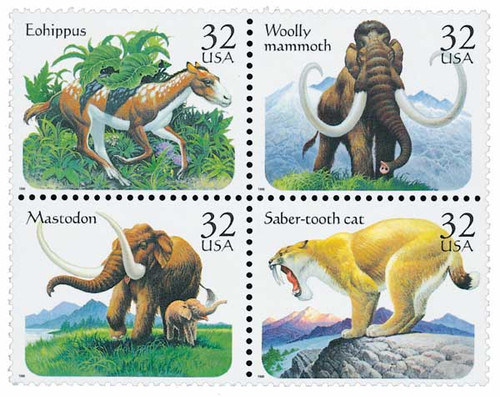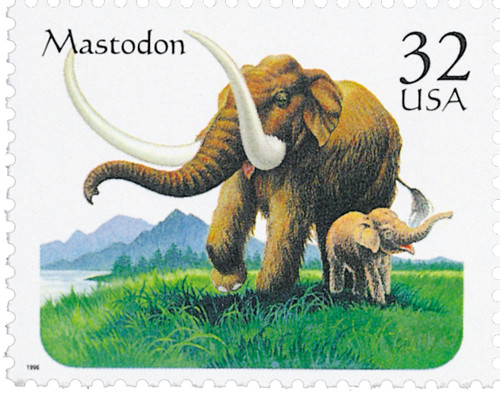
# 3080 - 1996 32c Prehistoric Animals: Saber-tooth Cat
US #3080
1996 Saber-tooth Cat
- Part of set of four picturing Prehistoric Animals
- Issued in semi-jumbo size
- Designed to appeal to young stamp collectors
Stamp Category: Commemorative
Set: Prehistoric Animals
Value: 32¢, First-class mail rate
First Day of Issue: June 8, 1996
First Day City: Toronto, Ontario, Canada
Quantity Issued: 27,772,500
Printed by: Ashton-Potter (USA) Ltd.
Printing Method: Lithographed
Format: Panes of 20 (4 across, 5 down) from plates of 120 (8 across, 15 down)
Perforations: 11.1 x 10.9
Why the stamp was issued: The four Prehistoric Animals stamps were issued to appeal to young stamp collectors. Ancient animals, such as these mammals, appeal to children. It was hoped, these stamps would spark an interest in stamp collecting that would last a lifetime.
About the stamp design: Davis Meltzer created the acrylic paintings used for these stamps. He referred to paintings by Charles Knight, who had painted many historic animals for the Museum of Natural History in New York City, as well as other sources. Dr. John Flynn, a prehistoric animal specialist with the Field Museum in Chicago was consulted after Meltzer’s paintings were complete to assure accuracy.
This set depicts the Eohippus, Woolly mammoth, Mastodon, and Saber-tooth cat.
Special design details: The Eohippus was much smaller than the other animals shown, so it was enlarged in comparison to fill the stamp space.
About the printing process: The stamps were originally intended to be printed using offset lithography and intaglio engraving. Printer Ashton-Potter was using a new press in 1995 when they tried to produce these stamps, and had issues with proper registration. The stamps were put on hold for a year. It was then decided they would be printed using only lithography.
First Day City: The Prehistoric Animals stamps were dedicated on the first day of Capex 96, held in Toronto, Canada. The sales of the stamps and First Day of Issue cancellations were handled by the Buffalo, New York, post office.
The stamps were originally scheduled to be issued at the American Philatelic Society’s annual convention but were delayed because of “technical problems with the printing process,” according to the USPS.
About the Prehistoric Animals set: This set shows four animals who roamed the ancient earth. Each one is an ancestor to modern animals. The fossil record gives scientists clues to what these creatures looked like and how they lived many years ago.
History the stamp represents:
The saber-tooth cat of prehistoric times is classified in a subfamily of the cat family (Felidae) called Machairodontinae. Saber-tooth cats were named for their large upper canine teeth. These teeth were curved like sabers, and could be up to eight inches long! The saber-tooth cats had very strong necks and skulls, their lower canines were relatively small in size, and their mouths could be opened to a 90-degree angle. All of these features suggest the saber-tooth cat used its canine teeth for stabbing and slashing its prey.
During the Pleistocene Epoch, the most famous of the saber-tooth cats, the Smilodon, appeared. This animal represented the peak of saber-tooth evolution. It was approximately the same size as a tiger, but stockier and with shorter limbs. Smilodon roamed all over North and South America hunting large plant-eaters such as mammoths. Many Smilodon bones have been preserved in the tar pits of Rancho La Brea in Los Angeles, California.
The saber-tooth cats became extinct during the time the last glaciers retreated north. The changing climate, the subsequent changes in plants, and the success of man were probably responsible for the demise of the saber-tooth cat.
US #3080
1996 Saber-tooth Cat
- Part of set of four picturing Prehistoric Animals
- Issued in semi-jumbo size
- Designed to appeal to young stamp collectors
Stamp Category: Commemorative
Set: Prehistoric Animals
Value: 32¢, First-class mail rate
First Day of Issue: June 8, 1996
First Day City: Toronto, Ontario, Canada
Quantity Issued: 27,772,500
Printed by: Ashton-Potter (USA) Ltd.
Printing Method: Lithographed
Format: Panes of 20 (4 across, 5 down) from plates of 120 (8 across, 15 down)
Perforations: 11.1 x 10.9
Why the stamp was issued: The four Prehistoric Animals stamps were issued to appeal to young stamp collectors. Ancient animals, such as these mammals, appeal to children. It was hoped, these stamps would spark an interest in stamp collecting that would last a lifetime.
About the stamp design: Davis Meltzer created the acrylic paintings used for these stamps. He referred to paintings by Charles Knight, who had painted many historic animals for the Museum of Natural History in New York City, as well as other sources. Dr. John Flynn, a prehistoric animal specialist with the Field Museum in Chicago was consulted after Meltzer’s paintings were complete to assure accuracy.
This set depicts the Eohippus, Woolly mammoth, Mastodon, and Saber-tooth cat.
Special design details: The Eohippus was much smaller than the other animals shown, so it was enlarged in comparison to fill the stamp space.
About the printing process: The stamps were originally intended to be printed using offset lithography and intaglio engraving. Printer Ashton-Potter was using a new press in 1995 when they tried to produce these stamps, and had issues with proper registration. The stamps were put on hold for a year. It was then decided they would be printed using only lithography.
First Day City: The Prehistoric Animals stamps were dedicated on the first day of Capex 96, held in Toronto, Canada. The sales of the stamps and First Day of Issue cancellations were handled by the Buffalo, New York, post office.
The stamps were originally scheduled to be issued at the American Philatelic Society’s annual convention but were delayed because of “technical problems with the printing process,” according to the USPS.
About the Prehistoric Animals set: This set shows four animals who roamed the ancient earth. Each one is an ancestor to modern animals. The fossil record gives scientists clues to what these creatures looked like and how they lived many years ago.
History the stamp represents:
The saber-tooth cat of prehistoric times is classified in a subfamily of the cat family (Felidae) called Machairodontinae. Saber-tooth cats were named for their large upper canine teeth. These teeth were curved like sabers, and could be up to eight inches long! The saber-tooth cats had very strong necks and skulls, their lower canines were relatively small in size, and their mouths could be opened to a 90-degree angle. All of these features suggest the saber-tooth cat used its canine teeth for stabbing and slashing its prey.
During the Pleistocene Epoch, the most famous of the saber-tooth cats, the Smilodon, appeared. This animal represented the peak of saber-tooth evolution. It was approximately the same size as a tiger, but stockier and with shorter limbs. Smilodon roamed all over North and South America hunting large plant-eaters such as mammoths. Many Smilodon bones have been preserved in the tar pits of Rancho La Brea in Los Angeles, California.
The saber-tooth cats became extinct during the time the last glaciers retreated north. The changing climate, the subsequent changes in plants, and the success of man were probably responsible for the demise of the saber-tooth cat.












